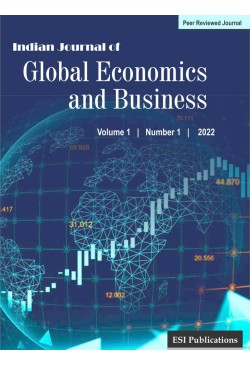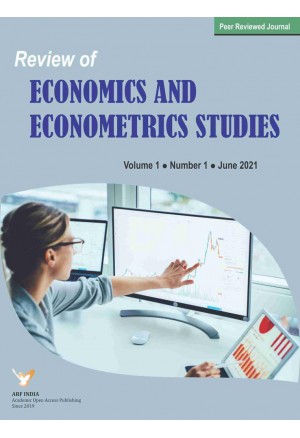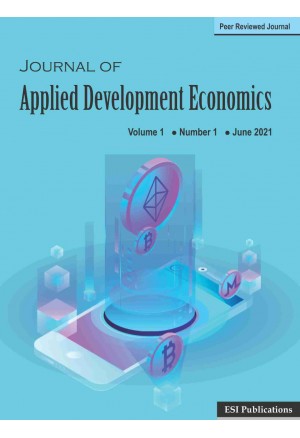IJGEBIndian Journal of Global Economics and Business

Peer Reviewed Journal
Find out more
Latest Articles :- Vol: (3) (2) (2024)
Magnitude of Formal and Informal Workers in India: Issues and Challenges
BY: Gaurav Bhatia and Tilak Raj
Indian Journal of Global Economics and Business, 2024, Vol: (3), Issue: (2), PP.87-99
Received: 23 June 2024, Revised: 22 July 2024, Accepted: 19 August 2024, Publication: 30 December 2024,
The present study analyze the magnitude of formal and informal workers as per the data disseminated by Ministry of Statistics and Programming Implementation, Labour Bureau, Employees’ Provident Fund Organization and Employee’s State Insurance Corporation from the period 1999-2000 to 2022-23. An attempt has been made to provide sector wise as well as economic activity wise number of workers at all over India. The study also reviews the facts pertaining to workers as per 6th Economic Census 2013-14 and the estimates provided by Quarterly Employment Survey (2021) being conducted by Labour Bureau. Study concludes that in the present scenario, it has become a formidable task to provide decent quality of life and work environment to workforce especially in informal sector as this sector provides valuable contribution to the formal sector. At all India level, it is imperative to monitor the size of workers in the formal and informal sector over time for designing appropriate policies.
Keywords: Informal sector, workforce, employment, Indian economy.
Gaurav Bhatia & Tilak Raj (2024). Magnitude of Formal and Informal Workers in India: Issues and Challenges. Indian Journal of Global Economics and Business, 3: 2, pp. 87-99.
Migration, Remittances, and Economic Development in India
BY: S. N. Tripathy
Indian Journal of Global Economics and Business, 2024, Vol: (3), Issue: (2), PP.101-121
Received: 29 June 2024, Revised: 27 July 2024, Accepted: 21 August 2024, Publication: 30 January 2025,
Remittances from Indian immigrants provide a significant source of income for households, contributing to poverty reduction, entrepreneurship, and investment, thereby catalyzing India’s socioeconomic development. Through an extensive review of literature, this paper has identified that remittance inflows significantly enhance Indian households’ livelihoods, boost consumption and investment, foster financial inclusion, stimulate entrepreneurship and innovation, develop the financial sector, and contribute to foreign exchange reserves accumulation. Nonetheless, it is essential to recognize the potential drawbacks and work towards diversifying the economy to reduce dependence on remittance inflows. Finally, this paper concludes that robust policies ensure the efficient utilization of these funds for socioeconomic development.
Keywords: Remittances, Socioeconomic development, Employment opportunities, Economic growth
JEL: F22, O15, J61
S. N. Tripathy (2024). Migration, Remittances, and Economic Development in India. Indian Journal of Global Economics and Business, 3: 2, pp. 101-121.
The Causal Relationship between International Private Transfers and Macroeconomics in India: Vector Error Correction Mechanism Estimation
BY: T. Lakshmanasamy
Indian Journal of Global Economics and Business, 2024, Vol: (3), Issue: (2), PP.123-131
Received: 10 September 2024, Revised: 17 October 2024, Accepted: 25 October 2024, Publication: 30 December 2024,
The flow of international private transfers to India is substantial and has a strong causal relationship with macroeconomic variables in India and with international variables. This paper examines the long-run causal relationship between international private transfers and six macroeconomic variables viz. private transfers, GDP, consumer price index, exchange rate, GDP of the US and international crude oil price for the period 1975 to 2022. The vector error correction model estimates show that an increase in the GDP of the US increases private transfers to India by 4.5%, whereas an increase in international crude oil price decreases private transfers to India by almost 1%. An increase in the GDP of India influences private transfers to India positively, while an increase in the consumer price index and exchange rate reduces private transfers to India. The negative error correction mechanism reveals that about 23.3% of short-run deviations in private transfers to India are adjusted in the long-run equilibrium.
Keywords: International private transfers, macroeconomics, causality, VECM estimation
T. Lakshmanasamy (2024). The Causal Relationship between International Private Transfers and Macroeconomics in India: Vector Error Correction Mechanism Estimation. Indian Journal of Global Economics and Business, 3: 2, pp. 123-131.
Effect of Post Covid-19 Sustainable Finance on Project Investment
BY: Chukwu, E. Peter, Enang, Ekwere Raymond and Ozor, Kelechukwu C.
Indian Journal of Global Economics and Business, 2024, Vol: (3), Issue: (2), PP.133-146
Received: 10 October 2024, Revised: 17 November 2024, Accepted: 28 November 2024, Publication: 30 December 2024,
This study examined the effect of post Covid-19 sustainable finance on project investment. A current issue at hand in the entire world, is the pandemic and how to sustain the economic development of several countries. It is against this background that this study is motivated to examine the effect of post Covid-19 sustainable finance on project investment. Ordinary Least Square Statistical tool was employed, SPSS version 21 software to run the analysis. The results revealed among other things that to determine the effect of post Covid-19 sustainable finance on project investment is significant. Thus, there is an urgent need for implement ESG in project investment in Nigeria in this post-Covid 19 era. The study recommended that the Federal Government should give serious attention and adequate considerations to Environmental moderation of climatic change and adaptation, preservation of biodiversity, pollution prevention, the circular economy, inequality, inclusiveness, labour relations, investment in human capital, communities, human rights issues. management structures, employee relations and executive remuneration – plays a fundamental role in ensuring the inclusion of social and environmental considerations in the decision-making process.
Keywords: post Covid-19, sustainable finance, project investment, economic development
Chukwu, E. Peter, Enang, Ekwere Raymond & Ozor, Kelechukwu C. (2024). Effect of Post Covid-19 Sustainable Finance on Project Investment. Indian Journal of Global Economics and Business, 3: 2, pp. 133-146.
Economic Implications of Stress in Asset Quality on Performance of Indian Economy: A Case of D-SIBs as a Whole Subsystem
BY: Ameen Uddin Ansari and Sanjeev Kumar
Indian Journal of Global Economics and Business, 2024, Vol: (3), Issue: (2), PP.147-161
Received: 16 October 2024, Revised: 27 November 2024, Accepted: 05 December 2024, Publication: 30 December 2024,
Post global financial crisis (2008), a new subsystem in Indian banking system had developed in the form of Domestic Systemically Important Banks(D-SIBs) as a whole since 2014 - A group of banks that are tagged Too Big To Fail and whose disorderly failure may cause failure of multiple banks- a kind of domino effect. Besides, the increasing number of Individual D-SIBs posing the problem of Too Many To Fail had also emerged in India. Therefore, in order to signify and highlight the role and importance of D-SIBs as a whole subsystem in entire Indian banking system and economy, the direct association between D-SIBs as a whole subsystem and Indian Economy had been investigated with the help of economic and financial data by tracing the economic implications of stress in asset quality of D-SIBs on the performance of Indian economy measured by GDP. For this, the study used autoregressive distributed lag model (0,1) based on the results of unit root test for period the spanning from 2000-01 to 2020-21 collected from secondary sources. In order to test the structural break, the study employed chow test. The results obtained from the ARDL approach (0,1) showed that stress in asset quality had negative effects on the performance of economy in the long run. This implied that D-SIBs as a whole subsystem displayed strong association with the Indian economy. This study made an appeal to the regulatory to pay special attention in this regard and suggested to treat differently not only individual domestic systemically important banks but also the problem of individual domestic systemically important banks in India. Unfortunately, individual domestic systemically important banks face differential treatment under Basel Norms III but not the problem of individual domestic systemically important banks in India.
Keywords: Economic Implications, Stress in Asset Quality, Domestic Systemically Important Bank, Gross Nonperforming Assets, ARDL
JEL Classification: G20, G28, G33
Ameen Uddin Ansari & Sanjeev Kumar (2024). Economic Implications of Stress in Asset Quality on Performance of Indian Economy: A Case of D-SIBs as a Whole Subsystem. Indian Journal of Global Economics and Business, 3: 2, pp. 147-161.
Copyright ©2023 ESI Publications. All Rights Reserved


-300x438.jpg)

